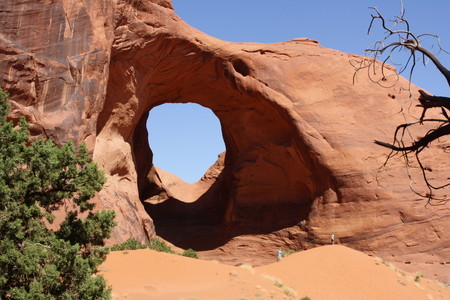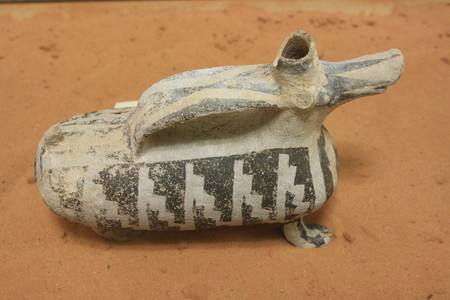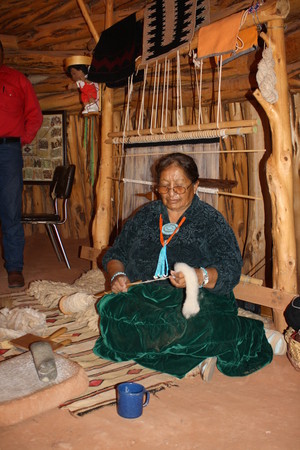Adventures along the San Juan
Only about 15,000 people live in the entire 7,933 square miles that is San Juan County, Utah. That leaves a lot of room for the rest of us to go adventuring there, and the opportunities are many.
Located in the Four Corners region and the heart of the Colorado Plateau, it's a good place for hiking, biking, climbing, camping or river rafting. By day, it boasts some of the most spectacular and unspoiled vistas the West affords; by night, some of the darkest skies for stargazing.
My daughters and I bit off about a week's worth recently and packed as much of it as possible into the four days we had available. By the end of our visit, we had seen dozens of historic sites, toured Monument Valley, hiked a few trails and spent a glorious and relaxing day rafting 26 miles down the San Juan River.
We set up "base camp" in Bluff, a former pioneer settlement from the 1880s, now home to a few hundred people. Our quarters were at the Recapture Lodge, nothing fancy but ideal for our purposes with clean rooms, an outdoor pool, the shade of deciduous trees and hiking trailheads on the property itself. It also was within walking distance of a small grocery store, a couple of good restaurants and Wild River Expeditions, the company that organized our raft trip.
On our first morning, we drove about an hour south from Bluff to one of the most famous and photographed landscapes in the world, the 30,000-acre Monument Valley Navajo Tribal Park.
We were taking a half-day tour with a Navajo guide from Goulding's Monument Valley Lodge, one of San Juan County's largest employers. Although surrounded by the Navajo reservation, Goulding's is privately owned as it was bought during a brief period of public domain in the 1920s. Tours are the only way to see some of the park's less-visited formations and cultural sites, as most of it is off limits to the public.
The open landscape allows long-range views of massive and perfectly formed mesas, buttes and arches; it's no wonder Hollywood came calling in the 1930s and exported those views to the world. John Ford shot nine westerns here and his name is remembered in John Ford Point, a position from which any visitor can see some of the very best of that scenery.
Because we were on a guided tour, we had the privilege of traveling to more remote areas as well, seeing many petroglyph panels, ruins and natural arches in the DeChelly sandstone -- including the Sun's Eye, Ear of the Wind, Moccasin and Big Hogan, the latter being a cave arch.
We also got a great look at the Totem Pole, a narrow spire that rises more than 500 feet above the valley floor, recognizable to many from a scene in "The Eiger Sanction" with Clint Eastwood, and many television commercials, including some for IBM and Jeep.
After our tour, we headed back north to the town of Blanding and the 16-acre Edge of the Cedars State Park and Museum. The two-story building serves as the archaeology repository for southeast Utah and displays hundreds of American Indian artifacts, such as pottery, tools and clothing. Some items are unique; in one display case there was a ceramic effigy found by a hiker in nearby Cedar Mesa in 2003. The effigy looks to be about nine or 10 inches long and appears as a composite of many animals, with four legs and a long snout. It is decorated as San Juan whiteware, which is also known as Mancos black-on-white.
Here also was a colorful sash fashioned from the feathers of a scarlet macaw, a parrot native to Mexico. Ancestral Puebloans were traders, and it's interesting to ponder whether they traded for the feathers only or for the live birds themselves. Estimated to date between 1050 and 1150, the sash has held its brilliant colors -- primarily bright red with a touch of blue in the center -- through all those centuries. A back-country guide found the sash in 1955 in a local cave.
A short walk outside, behind the museum on a small knoll, we toured the Pre-Columbian Pueblo Indian ruin and scattered foundations from an unexcavated village, all thought to have been occupied between 750 and 1300. Here, you can descend into a kiva, an underground room thought to have been used for religious ceremonies.
The next morning, we were up early and headed over to Wild River Expeditions. We hopped into the waiting van for a short drive to the launching spot at Sand Island Recreation Area on the San Juan River. Besides the three of us, our group consisted of a family of five from Texas, and a cheerful river guide, Marcus Buck, who grew up on the nearby Navajo reservation.
We all loaded into one inflatable raft, complete with oars as well as a motor, with Buck suggesting the heavier people sit towards the middle or stern. Our day would consist of traveling about 26 miles downstream to the small town of Mexican Hat. Along the way we would stop a few times to visit historic American Indian sites, swim and have lunch.
Our first stop was about six miles downstream at the Butler Wash petroglyph site. There are hundreds of petroglyphs here, including anthropomorphs, or humanlike figures, from the Basketmaker ancestors of the Anasazi culture.
As we floated farther downstream, Buck pointed out the Moki (Moqui) Steps, carved into the sandstone hundreds of years ago to help people more easily walk up the steep rock. I have found prehistoric carved steps while hiking elsewhere, but only in very steep areas. The fact that somebody took the trouble to carve dozens in this more gradual incline suggests something important was going on here, but we don't know what.
Our next stop was at a sandy beach where we were taking a short hike to visit the River House ruins. Like most dwellings of this area and era -- between 1150 and 1300 -- it was built under a natural rock overhang, preserving it so well that today's visitors are allowed to explore the ruin and enter the different rooms.
Back at the river bank, Buck pointed out how we easily could walk upstream a few hundred yards and then float back down the river with our life preservers. This proved so merry and relaxing that I happily could have continued all day. We got in four or five repetitions while Buck made lunch. He served several types of lunch meats, hummus, relish, pesto and a wonderful green hot pepper sauce, a gourmet meal by wilderness standards, and one that easily lured us from aquatic pleasures.
Geology in this area is diverse, and Buck did his best to get all of us interested in it.
Just seeing the wildlife is worth the trip down the river; we were treated to a few dozen bighorn sheep, six great blue herons, a flock of Canadian geese, several hummingbirds, a fox, a few wild turkeys and a turkey vulture. We did see a few other groups traveling the river, but for the most part, we had the river and the wildlife to ourselves.
Because of water flow and time of year, the San Juan rafting experience varies from day to day. For us, it was mostly a leisurely float trip with a dozen or so short whitewater sections. But at one point, we talked to people drying their clothes on the branches of bushes and trees. They had flipped their raft and lost their oars about a quarter mile upstream, in a section we negotiated shortly after them with no trouble at all.
About five miles from where we would end our raft trip, we had stopped for another swim and to check out a rich fossil bed, when the wind began blowing hard and the sky turned red from the airborne sand. We had to hunker in the vegetation for at least 10 minutes as the sand pelted us, before it calmed down. Thunder and lightning rioted in the distance as we sneaked downstream to our destination, the small town of Mexican Hat. It's named for an enormous sandstone formation that suggests an upside-down sombrero.
As the wild weather headed east, I thought we were done with its discomforts. But upon returning to our hotel in Bluff, we learned it had knocked out power in the entire town, closing the one store and gas station, as well as the restaurants. After a day on the river, we had been looking forward to a big dinner at the Cottonwood Steakhouse, which had proven excellent the night before, or the Twin Rocks Café, which we were told is also great, but the power outage forced us to dine on peanut butter and jelly sandwiches from our road-trip supplies.
On any more normal, cloud-free night, someone interested in astronomy will love this area, as San Juan County has almost no light pollution to dull its starry skies. If you are interested in stargazing, a trip over to Natural Bridges National Monument is well worth it; it's one of the best places in the Lower 48 to view the Milky Way. The International Dark-Sky Association designated the park as the world's first International Dark Sky Park. Beginning at dark on Friday and Saturday nights through October, you can take part in a ranger program, when telescopes will be set up.
On our fourth day, we visited a few more scenic spots. We saved one of the most spectacular, a viewpoint at Gooseneck State Park, for our last stop before leaving San Juan County and heading home. Standing on a windy bluff, we looked 1,000 feet below to the entrenched river meander, which had created the gooseneck shapes. The river makes hairpin turns and it flows six miles while advancing only one-and-one-half miles west, as a proverbial crow would fly it, toward Lake Powell.
The area lies just a few miles downstream from Mexican Hat, where we had left the river on our raft trip. And it occurred to all three of us more or less simultaneously that we shall return for the rest of our week's worth of San Juan County, to include an 84-mile raft trip from Bluff to Lake Powell, right through that luring, loopy section called the Goosenecks.




















